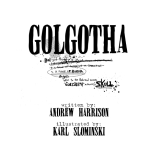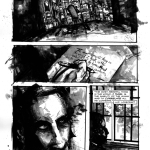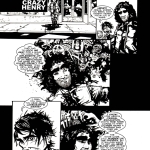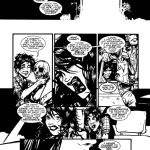 AMBER LOVE 12-MAR-2013 From the belly of 215ink, comes GOLGOTHA, a comic that leaves me asking, “Why didn’t anyone think of this sooner?†Andrew Harrison and Karl Slominski present a fresh story about horror icon H.P. Lovecraft. Graverobbers strike at Lovecraft’s final resting place, Swan Point Cemetery in Providence, Rhode Island. GOLGOTHA is 130 pages accessible for even non-Lovecraft readers so you don’t have to worry that you need to be a scholar of the occult to enjoy this.
AMBER LOVE 12-MAR-2013 From the belly of 215ink, comes GOLGOTHA, a comic that leaves me asking, “Why didn’t anyone think of this sooner?†Andrew Harrison and Karl Slominski present a fresh story about horror icon H.P. Lovecraft. Graverobbers strike at Lovecraft’s final resting place, Swan Point Cemetery in Providence, Rhode Island. GOLGOTHA is 130 pages accessible for even non-Lovecraft readers so you don’t have to worry that you need to be a scholar of the occult to enjoy this.
Slominski’s inking encases the panels in the murkiness of the genre that brings out a heavy sense of doom. It’s the style that I don’t see often but when I do, I am immersed completely in the scene. Those ink wash shadows and textures come back during flashbacks. As the story shifts to the modern era, the inks become crisp with drastic shadows of Rhode Island’s foliage and architecture. The design of the common people reflects the zeitgeist of the late 1990s. Slominski’s art also excels at drawing the reader’s eye directly to the character on point in each panel through his use of leaving background characters in a minimalistic black and white line style without any midtones and the foreground characters are heavily blackened. The pages have varying panel layouts from six panel grids to full bleeds overlaid with skewed insert panels to give the pace necessary adjustments.
Aleister Bloom is an artist on trial, an obvious nod to another cult icon, Aleister Crowley known for his heavy drug use; and Bloom may refer to Benjamin Bloom’s Taxonomy of education and problem solving or Bloom could be a throwback to the character Mr. Bloom in Walter de la Mare’s story, “A Recluse†(1926). Harrison’s Aleister Blooms lands in court-ordered drug rehab at the Thompson Rehabilitation Center, another Easter egg for name nerds. Even the character Jude seems to be carefully bestowed with the burden of a name of greater significance, Jude being the patron saint of lost causes.
Readers will have no problem accepting that Aleister’s mission is to leave Rhode Island and get to New York but recovering Lovecraft’s skull alters his plans. Upon reading the news of the skull’s disappearance, Aleister needs to escape the rehab center for a more pressing reason than moving to New York.
Harrison clearly has fun in his storytelling. He’s able to point out the flaws in the icon, Lovecraft and also give the protagonist some unlikable qualities. He also some knowledge of the art scene that he adeptly mocks in ways such as captioning a location: “SOME PRETENTIOUS ART GALLERY.†Similar quirkiness comes out in the narrative and visuals of the characters. Crazy Henry’s head is shown like a collage of wild images dancing around; the drug dealers Shawgrim and Grimshaw have a very “Jay and Silent Bob†vibe and Harrison is able to break out with surprises that while these characters might be morons on a particular level, they have wiles. Crazy Henry’s contributions to the conversations are like a mystic oracle’s revelations that are somewhat literal and somewhat coded. Moira is the token goth girl whose vice is morphine which she had been scoring from her hospital job but she’s chased out of there at high speed with the entourage of addicts in pursuit of Lovecraft’s skull.
Crazy Henry is the one that feels enough connection with the universe to tell Aleister what’s happening now that the remains have been disturbed. The skull’s theft has has essentially caused enough disruption in Lovecraft’s remains which were functioning as an anchor or barrier between the third and fourth dimensions of reality. With the skull missing, weird shit is taking over.
The advanced readers’ copy had a couple of small typos and format glitches that hopefully will get adjusted in the final copies. And if you couldn’t guess, it’s definitely “M†for Mature due to drug use, sex and language; nothing a teenager would be shocked reading but shouldn’t be under 14.






